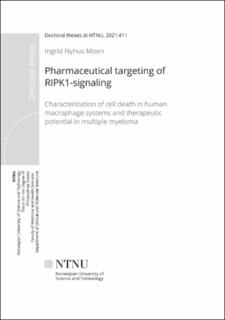| dc.contributor.advisor | Starheim, Kristian K. | |
| dc.contributor.advisor | Bjørkøy, Geir | |
| dc.contributor.author | Moen, Ingrid Nyhus | |
| dc.date.accessioned | 2022-02-01T08:49:49Z | |
| dc.date.available | 2022-02-01T08:49:49Z | |
| dc.date.issued | 2021 | |
| dc.identifier.isbn | 978-82-326-6757-4 | |
| dc.identifier.issn | 2703-8084 | |
| dc.identifier.uri | https://hdl.handle.net/11250/2976171 | |
| dc.description.abstract | The receptor-interacting protein kinase 1 (RIPK1)-pathway is a key regulator of inflammation and cell death. RIPK1-dependent cell death has been well studied in murine macrophages but as it is context dependent and differently regulated in humans, more knowledge on pharmaceutically induced cell death in human macrophages are needed. Our aim for this thesis was thus to contribute to a better understanding of pharmaceutical induction of RIPK1- dependent cell death in a context of human osteoclasts (OC) and other macrophage subtypes.
Pharmaceutical targeting of RIPK1-signaling by drugs like Smac-mimetics (SM) and TGF-β- activated kinase 1 (TAK1)-inhibitors has been extensively studied as therapeutic options in both cancer and other chronic diseases like psoriasis and inflammatory bowel disease, but studies on primary human immune cells have been warranted. Currently, SM are in clinical trials in cancers such as multiple myeloma (MM) and as OC contribute to the disease pathology, the effect of SM on these cells should be investigated. In addition, TAK1 has been found to be a driver of MM and necessary for osteoclastogenesis in mice. TAK1-inhibitors could thus be a novel therapeutic option as an antitumorigenic agent and in reducing bone disease in MM-patients.
In paper I we sought to investigate the effect of SM-treatment on human OC and the possible beneficial role in MM therapy. We demonstrated that the SM birinapant and LCL-161 restrained osteoclastogenesis and induced TNF-dependent cytotoxicity in primary human OC. Birinapant induced apoptosis, and also necroptosis in some donors. In addition, we discovered that both SM blocked osteoclastogenesis induced by myeloma patient bone-marrow aspirates, proposing an additional benefit by reducing bone degradation in patients.
The objective of paper II was to investigate the effect of pro- and anti-inflammatory pretreatment on SM-induced cell death in human macrophages. We found that pro- and anti-inflammatory treatment dictated the sensitivity and cell death mechanism induced by the SM birinapant and LCL-161. LPS pretreated macrophages were considerably more susceptible to cell death compared to the other tested subtypes, which was caused by a potentiation of apoptosis. In contrast, the other tested subtypes depended on the necroptotic machinery for full birinapant cytotoxicity, an intriguing observation as necroptosis could be induced in a setting were caspase activity was functional. Birinapant-induced apoptosis in LPS pretreated macrophages was accompanied by IL-1β release independent of caspase 1. Taken together, our findings suggest a therapeutic potential of SM in a disease setting where inflammatory upregulation of macrophages is involved.
Paper III focuses on the effect of TAK1-inhibitor treatment on MM cells and the possible beneficial effect on human OC. We demonstrated that the TAK1-inhibitors NG25 and 5Z-7- oxozeaenol (5Z-7) were cytotoxic to MM cell lines and patient cells both alone and in combination with the DNA-damaging drug melphalan. In addition, NG25 and 5Z-7 reduced differentiation and viability of human OC, suggesting a double beneficial effect for patients by reducing bone disease.
Altogether, this work contributes to the understanding of pharmaceutical targeting of RIPK1- signaling in human macrophage systems and points out potential therapy candidates for treatment of inflammatory conditions and cancers such as MM. | en_US |
| dc.language.iso | eng | en_US |
| dc.publisher | NTNU | en_US |
| dc.relation.ispartofseries | Doktoravhandlingar ved NTNU;2021:411 | |
| dc.relation.haspart | Paper 1: Moen, Ingrid Nyhus; Westhrin, Marita; Håland, Erling; Haug, Markus; Nonstad, Unni; Klaharn, Merisa; Standal, Therese; Starheim, Kristian K.. Smac-mimetics reduce numbers and viability of human osteoclasts. Cell death discovery 2021 ;Volum 7:36. s. 1-11 https://doi.org/10.1038/s41420-021-00415-1 This article is licensed under a Creative Commons Attribution 4.0 International License (CC BY 4.0) | en_US |
| dc.relation.haspart | Paper 2:
Moen, Ingrid Nyhus; Klaharn, Merisa; Holter-Sørensen, Marie; Sharma, Animesh; Starheim, Kristian K.
Pro- and anti-inflammatory treatment dictates Smac-mimetic cytotoxicity in human macrophages. | en_US |
| dc.relation.haspart | Paper 3: Håland, Erling; Moen, Ingrid Nyhus; Veidal, Elias; Hella, Hanne; Misund, Kristine; Slørdahl, Tobias Schmidt; Starheim, Kristian K.. TAK1-inhibitors are cytotoxic for multiple myeloma cells alone and in combination with melphalan.
The final version is published in
OncoTarget 2021 ;Volum 12.(21) s. 2158-2168 https://doi.org/10.18632/oncotarget.28073 This is an open access article distributed under the terms of the Creative Commons Attribution License (CC BY 3.0) | en_US |
| dc.title | Pharmaceutical targeting of RIPK1-signaling: Characterization of cell death in human macrophage systems and therapeutic potential in multiple myeloma | en_US |
| dc.type | Doctoral thesis | en_US |
| dc.subject.nsi | VDP::Medical disciplines: 700 | en_US |

